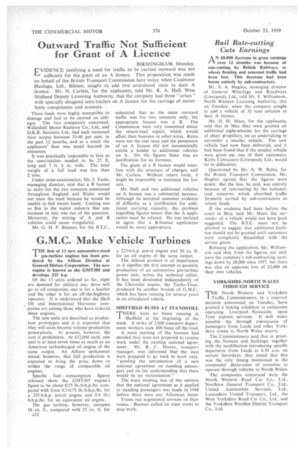Outward Traffic Not Sufficient for Grant of A Licence
Page 34

If you've noticed an error in this article please click here to report it so we can fix it.
BIRMINGHAM, Monday. VIDENCE justifying a need for traffic to be carried outward was not sufficient for the grant of an A licence. This proposition was made on behalf of the British Transport Commission here today when Coalmoor Haulage, Ltd., Bilston, sought to add two articulated units to their A licence. Mr. N. Carless, for the applicants, told Mr. R. A. Hall, West Midland Deputy Licensing Authority, that the company had three " artics " with specially designed semi-trailers on A licence for the carriage of motor body components and scooters.
These loads were highly susceptible to damage and had to be carried on stillages. The two companies concerned, Willenhall Motor Radiator Co., Ltd., and D.K.R. Scooters, Ltd., had each increased their output between 33-40 per cent in the past 12 months, and as a result the applicants' fleet was taxed beyond its resources.
It was practically impossible to hire as the semi-trailers needed to be 27 ft. long and 7 ft. 6 in. wide. The total weight of a full load was less than 2 tons.
Under cross-examination, Mr. I. Took, managing director, said that a B licence to carry for the two concerns mentioned throughout England and Wales would not meet the need because he would be unable to find return loads. Costing was so fine in the motor industry that any increase in rate was out of the question. Moreover, the mixing of A. and B vehicles could cause irregularity.
Mr. G. H. P. Beames, for the B.T.C., submitted that as the main outward traffic was for two concerns only, the appropriate licence was a B, The Commission were very concerned about the return-load aspect, which would affect their business in other areas. Rates were not the real issue and the possession of an A licence did not automatically
entitle holder to additional vehicles• on A. On the figures there was no justification for an increase.
The grant of a B licence would interfere with the structure of charges, said Mr. Carless. Without return loads, it might be impossible to maintain the low rate.
Mr. Hall said two additional vehicles on A licence was a substantial increase. Although he accepted customer evidence of difficulty as a justification for additional carrying capacity, the problem regarding figures meant that the A application must be refused. He was inclined to agree that a B-licence application would be more appropriate.




































































































